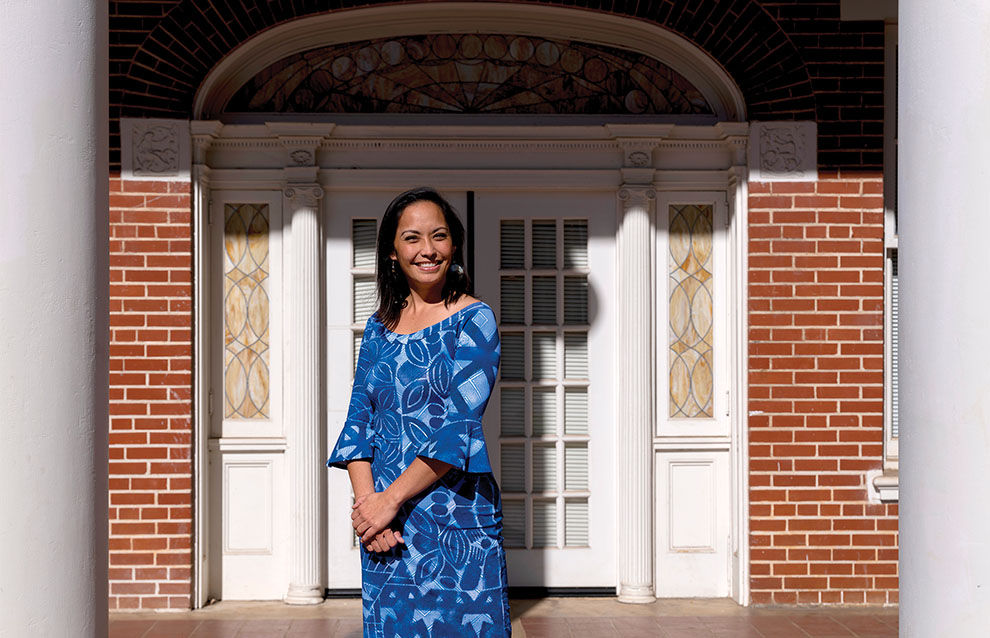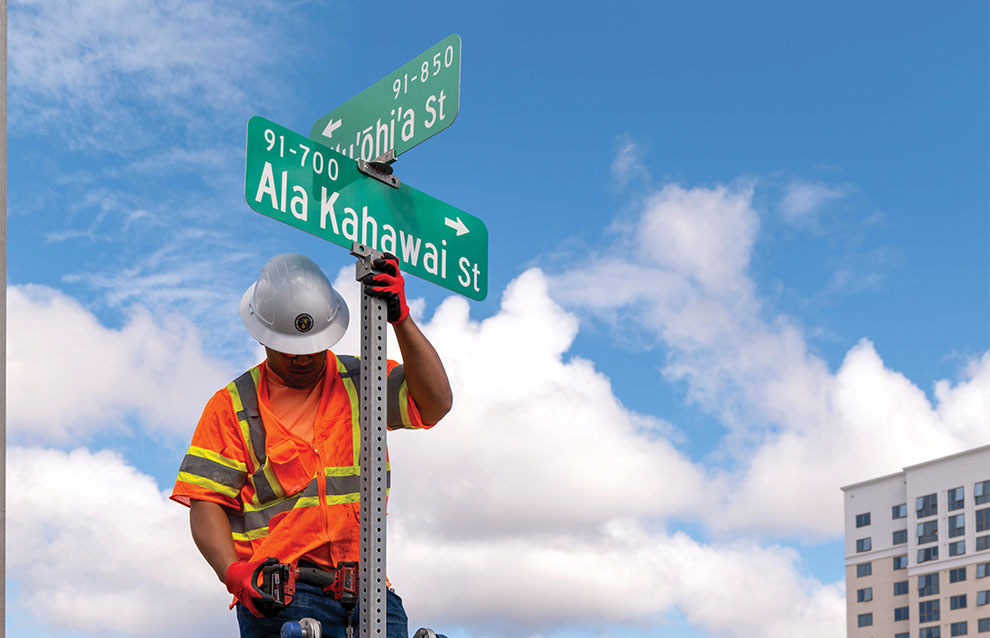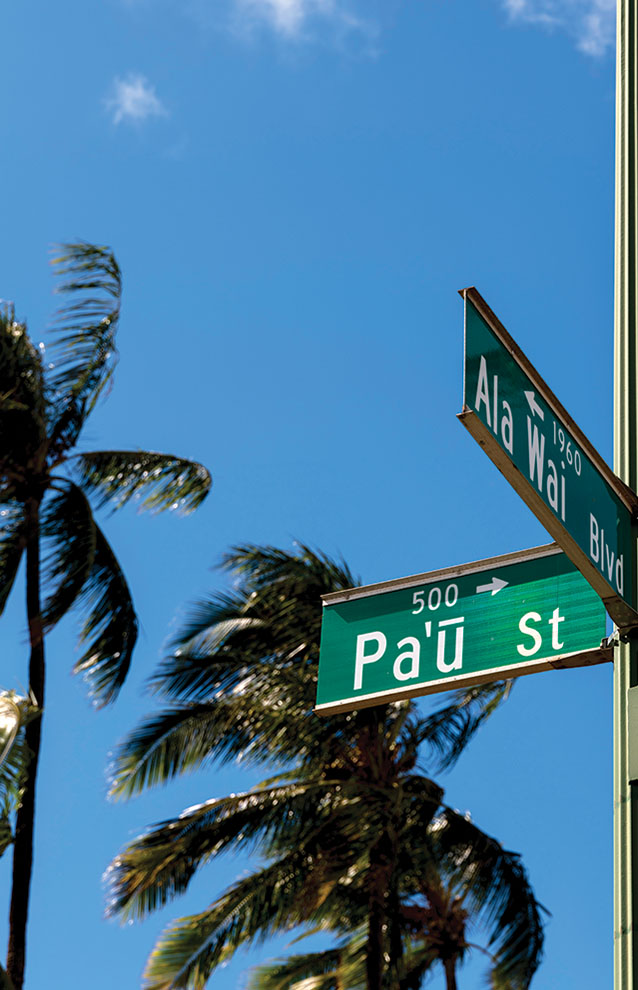The trouble with Honolulu's street signs became clear to Makanani Sala and Jayme-Lee Mokulehua on the day in 2021 when they were leaving a meeting at Kapolei Hale. They noticed the signs on either corner outside of the building, the City and County of Honolulu's administrative center in West Oahu, were spelled differently. One sign read Uluohia Street, the other Uluohia Street.
Driving around the block, they discovered two more variations: Uluohia and Uluohia. One short street smack in the heart of the Kapolei Civic Center, right under the nose of the city government, was spelled four different ways. "How does that happen?" Sala marveled.
Diacritic marks are essential in modern Hawaiian spelling. The kahako (a macron indicating a long vowel) and the okina (an inverted and reversed apostrophe signifying a glottal stop) affect a word's pronunciation. Changing the pronunciation changes the meaning: pua is a flower, pua is a flock and pua means to excrete. Both Sala and Mokulehua, who speak Hawaiian and are acutely aware of the proper use of okina and kahako, were dumbstruck to find a Hawaiian-named street with a different spelling on every corner. "We couldn't unsee that once we saw it," says Sala, a former Hawaiian studies instructor at Windward Community College.
As they drove around that day, they discovered more diacritical goof-ups. The most cringeworthy was on Ala Kahawai Street. One deeply misguided sign had it as "Ala Kahawai," with okina butted up against consonants, something okina aren't allowed to do. "Anyone who speaks Hawaiian knows that's wrong," Mokulehua says. "It doesn't make any sense like that."
The problem was definitely worth a complaint to City Hall-and because the women both work for the city, they took it upon themselves to deal with it. Sala is the executive director of the Mayor's Office of Culture and the Arts (MOCA), and Mokulehua is the office manager. MOCA coordinates the city's involvement in events like parades, festivals and block parties; it commissions artwork for the Art in City Buildings program and manages Honolulu's sister city relationships; it stages the month-long Honolulu City Lights holiday spectacular. Proofreading city street signs has never been on its to-do list.

The Hawaiian language's two essential diacritics, the okina and the kahako, have been included on Honolulu street signs since 1979, but they haven't always been used correctly. At the city's Sign Fabrication Shop (seen on page 52) a pair of decommissioned signs is on display. Above, an older sign at the corner of Nuuanu and Judd awaits the addition of an okina.
But MOCA's mission is to "provide equal and abundant opportunity for exposure to culture and the arts in all its forms." Most of Honolulu's streets have Hawaiian names. What are all these names doing if not providing the people of Honolulu with "abundant opportunity for exposure" to Hawaiian culture? Why shouldn't spellchecking fall under MOCA's purview? Sala showed photos of the Kapolei signs to mayor Rick Blangiardi, and he was roused. "A hallmark of this administration is that if you see a problem, you jump in and fix it," says Sala. "So we just made it ours."
In February 2022, in conjunction with Mahina Olelo Hawaii, Hawaiian Language Month, MOCA issued a call for Oahu residents to tip off the city to misspelled street signs via Instagram or MOCA's website. Sala dubbed it the Word on the Street project, posted a few YouTube videos and got some press coverage to promote it. "Our team here will be building an inventory that will be used to create new signs and recommission old signs," she announced.
Word on the Street netted more than thirty misspelled Hawaiian streets. Most were unequivocally incorrect. These include streets named after well-known places (Kaneohe Bay Drive, Nanakuli Avenue), historic figures or characters (Hiiaka Street, named for one of the goddess Pele's many sisters) and common words without more than one possible spelling (Kuaaina "countryside" Way; Hakiokio "flute" Place).
To determine the correct spellings, Sala and Mokulehua used the Hawaiian Dictionary, by Mary Kawena Pukui and Samuel Elbert, and Place Names of Hawaii, by Pukui, Elbert and Esther Mookini. Old land-use records and even oral histories could be helpful, too, Sala says. Her and Mokulehua's background in the Hawaiian language is indispensable. At Uluohia Street they recognized a compound word-ulu meaning "grove" and ohia an endemic Hawaiian tree. "It means a grove of ohia trees," Sala says. "Only one of the signs got it right."

After discovering multiple misspellings of a Hawaiian street name outside of West Oahu's satellite city hall, Makanani Sala, head of the Mayor's Office of Culture and the Arts (seen above), started a social media campaign to identify spelling problems on other street signs. The Word on the Street project launched last February, coinciding with Mahina Olelo Hawaii, Hawaiian-language Month.
But things aren't always so clear-cut. Take Pau Street in Waikiki, a street with two names. At Kuhio Avenue it's Pau, while at Ala Wai Boulevard it's Pau. An entry for Pau Street in Place Names of Hawaii notes that the street was named by the developer, that pau means "finished" and that "canoe races on the Ala Wai Canal finished here." From that it's easy to infer the street was named because canoe races finished there. But that's not exactly what Place Names says.
The person who submitted Pau Street provided complicating details, including a map from the 1880s showing an old Hawaiian land division named "A Lele of Pau" precisely where Pau Street now lies. The developer, Bruce Cartwright, was a president of the Hawaiian Historical Society. He surely would have known the land-use history of his subdivision. Furthermore, the street was named in 1926, two years before the Ala Wai Canal was completed and a few more years before paddling races there became a thing.
So the question became, How would Lele of Pau have been originally pronounced, when Hawaiian was still widely spoken and okina and kahako were confined to the missionary dictionaries? Could it have been pronounced pau, meaning moist, damp or soaked, like the great wetland that Waikiki once was? Which sign is correct, Pau or Pau? Soaked or finished? Sala is still working on that one, but when in doubt she defaults to no diacritics. "If it doesn't become apparent," she says, "it stays Pau."
Honolulu has given its streets Hawaiian names for as long as it has had streets. Alakea, Kawaiahao, Maunakea and Nuuanu are some of the oldest streets on Oahu. But in the early years it was the King Streets, Queen Streets, Smith Streets and Merchant Streets that predominated. Hawaiian names didn't take the lead until the early twentieth century, after the city adopted an informal policy of using Hawaii's mother tongue for its new streets.
Today there are about eight thousand city streets in Honolulu, and most of them have Hawaiian names. Initially none of them bore diacritical marks. The Hawaiian cultural renaissance of the 1960s and 1970s, with its emphasis on reviving the language, changed that. Hawaiian language advocates succeeded in having Hawaiian declared an official state language in 1978; they followed up in 1979 with a city ordinance requiring Hawaiian names on new streets. Until then exceptions were routinely made to the Hawaiian names rule. The new law also required proper diacritical marks on both new and replacement street signs.

At the corner of Ala Kahawai (not Ala Kahawai, as it had been) and Uluohia (not Uluohia, Uluohia or Uluohia) a city worker replaces two misspelled street signs with corrected versions. Most of Honolulu's eight thousand city streets have Hawaiian names, and many of the street signs have missing or misplaced diacritics. (BELOW) What's the name of this Waikiki street? At one end it's Pau, meaning wet, like the great wetlands of old Waikiki. At the other end it's Pau, meaning finished. Paddling races on the Ala Wai Canal finished near the street's end in the 1930s, but that's probably coincidental. Most likely the street was named for an old Hawaiian land division. But should that land division be pronounced pau or pau? With the street itself offering two choices, take your pick.

Not everyone appreciated all those squiggles and bars cluttering the airspace above Hawaiian street names. One high-placed critic was John Hirten, a former federal transportation official who came to Honolulu in the 1980s as the city's director of the Department of Transportation Services. During a 1986 Waikiki beautification project, Hirten had five hundred new street signs put up, flouting the law by omitting diacritics.
From Kalia Road to Liliuokalani Avenue, not a single okina or kahako appeared on Hirten's new blue signs. "Those markings make signs very difficult to read-they're confusing both to tourists and to local people. And they make signs much more expensive," he explained to a Honolulu Star-Bulletin reporter in May 1986. "I don't know how that law got on the books in the first place." He added that he hoped to have the law changed.
The backlash behind the scenes must have been convincing, for a week later Hirten reversed himself on all counts: The signs would be fixed, doing it right wouldn't cost more and he had "better things to do" than fight the law. With okina and kahako cut from rolls of reflective tape, workers squeezed awkward edits onto Kaiulani Avenue, Kuhio Avenue, Kalakaua Avenue and a dozen other streets. The signs looked terrible, but there they were.
Honolulu's policy of giving its streets Hawaiian names dates to 1915, with the creation of the city's Planning Commission. As an advisory body to the Board of Supervisors (the predecessor of the City Council), the commission's role was to bring order to a rapidly growing city's haphazard development. Recommending street names was part of its job, and it established the practice of preferring short, euphonious Hawaiian names.
Promoters of Hawaii saw this as a simple way to enhance the Islands' allure. There was also a sense among residents that a bit of the old Hawaii vanishing before their eyes could be preserved in street names. The 1935 Planning Commission president, James McInerny, described the policy as "a simple but effective way to create Hawaiian atmosphere and also to perpetuate the Hawaiian language, which is rapidly dying out through lack of use."
With postwar development booming in the late 1940s and 1950s, the Planning Commission went into overdrive proposing new Hawaiian street names. The Board of Supervisors didn't always accept the recommendations, but usually it did. Of the 113 streets named in 1954, all but nine got Hawaiian names.
Developers and residents along unnamed streets sometimes recommended names, but more often they came from Planning Commission staff combing through Hawaiian dictionaries. By the late 1950s the easiest pickings had been plucked. In 1957 Planning Commission director George Houghtailing, seeking to relax the Hawaiian names rule, warned of a looming shortage. "Gentlemen, the Hawaiian alphabet has only twelve letters," Houghtailing declared in The Honolulu Advertiser (by today's count the alphabet has thirteen letters, with the okina treated as a consonant). "You can make just so many easily pronounceable words out of twelve letters, and the supply is getting mighty short."
Nonsense, replied the Hawaiian Civic Club of Honolulu, which promptly provided the city a list of 587 Hawaiian names. Heavy on fruit, fish, flowers, celestial bodies and adjectives, the list was expected to keep the city in street names for the next five years.
Perhaps the most outspoken champion of the Hawaiian naming policy was a gruff real estate broker named George Centeio, who sat on the Planning Commission from 1954 to 1966. "We don't need haole names," he told The Honolulu Advertiser in 1965. "There are as many Hawaiian names as there are haole names." When the Planning Commission broke with its own rule in 1965 by recommending that a street be named Von Hamm Place, it was at a meeting that Centeio did not attend.
By this time the Hawaiian language revival movement was stirring, and in 1968 the City Council enshrined the Hawaiian naming policy into law. The move would forestall future Von Hamm Places, but with a gaping loophole for developers who could make a convincing case for non-Hawaiian names. The 1979 law closed the loophole and added the diacritic requirement. It also moved final naming decisions into the hands of the planning department, removing Planning Commission and City Council politics from the equation.
Of course, passing a law is one thing, and implementing it without misspelled Hawaiian words all over the place is another-as Uluohia Street proves.
Though it has been forty years since Honolulu has required diacritics on its street signs, the city has yet to come up with a reliable way to manage Hawaiian spelling. The private developers initially responsible for installing signage along new roads and city teams who replace old or missing street signs have all had their own ideas about the proper usage of okina and kahako. The Word on the Street project isn't a comprehensive overhaul of this dysfunctional system; it's a work in progress, a step in the right direction.
Sala is still working on how to get the corrections Word on the Street identifies to stick. She knew if she had waited to begin until she had all the answers, the project never would have gotten off the ground. "Sometimes you just gotta go 'guerilla action,'" she says. "We decided to just start, put it on people's radar and figure it out as we go."
Not long after Word on the Street launched, a city worker in a safety-orange vest climbed a ladder to the top of a signpost in Kapolei and pressed a tiny rectangle of reflective tape above an "o," changing Uluohia to Uluohia. A quick fix a la John Hirten. But thanks to the headroom above the lettering on newer signs, this makeshift kahako fit perfectly.
A few months later that same worker was back, climbing the street post a block away. He removed the Uluohia sign, its letters too tightly spaced for reflective-tape okina, and replaced it with a brand-new Uluohia sign. On the same signpost he swapped the Ala Kahawai sign-with its outrageously misplaced okina-with a corrected sign reading "Ala Kahawai." It was a twofer: one signpost, two corrections.
Ala Kahawai Street now reads correctly from one end to the other, and Uluohia Street is making progress. In this small way, the copy-editing of Honolulu's street signs has begun. "Most people won't even notice," says Sala. "But for the people who know, it's such a big deal."
To report a misspelled city street sign, tag a photo on Instagram @HNL_MOCA with hashtag #WordOnTheStreet, or fill out the Google Form at honolulumoca.org.


